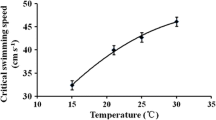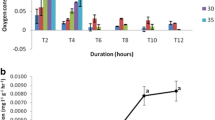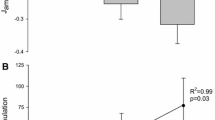Abstract
Ammonium overloading is a common response of aquatic organisms to air exposure during transport. This study elucidated the relationship between ammonium overloading and mortality of crab Portunus trituberculatus. Additionally, we also explored the effects of emersion time and air temperature on ammonium loading and concomitant physiological change. To test the air temperature effect, the crab was exposed to 16, 23 and 30°C in air for 3 h, respectively, and then recovered in seawater at 23°C for 12 h. To test the emersion time effect, crab was exposed to 23°C in air for 0.5 and 3 h, respectively, and then recovered in seawater at 23°C for 12 h. In the control group, crab was always immersed at 23°C. At each time interval (0.5, 1.5 and 3 h during air exposure and 0.5, 2, 4 and 12 h during recovery), ammonium excretion rate, level of total ammonium, total free amino acids and urea concentration in hemolymph and the hepatopancreas enzyme activity involved in detoxifying ammonium were analysed. Results showed that crab mortality was positively related with emersion time and temperature while ammonium loading was lower at 16 and 30°C than at 23°C. For crab experiencing thermal inconsistence of culture media (i.e., 16 or 30°C), they were higher in ammonium excretion rate and activities of ammonium detoxification enzymes, which may be the reason that they had a lower ammonium loading. Prolonged emersion time (3.0 h vs. 0.5 h) increased the ammonium overloading and the activity of ammonium detoxification pathways in crab. Our results demonstrated that emersion-induced ammonium overloading may not be the main reason leading to P. trituberculatus death during air exposure and subsequent recovery. When the culture medium changed, thermal variation, compared with constant temperature, could reduce ammonium overloading in crab by elevating the activities of ammonium detoxification enzymes and ammonium excretion rate during recovery period.
Similar content being viewed by others
References
Barrento, S., Marques, A., Vaz-Pires, P., and Leonor Nunes, M., 2011. Cancer pagurus (Linnaeus, 1758) physiological responses to simulated live transport: Influence of temperature, air exposure and AQUI-S®. Journal of Thermal Biology, 36: 128–137.
Bergmann, M., Taylor, A. C., and Geoffrey Moore, P., 2001. Physiological stress in decapod crustaceans (Munida rugosa and Liocarcinus depurator) discarded in the Clyde Nephrops fishery. Journal of Experimental Marine Biology and Ecology, 259: 215–229.
Bernardi, C., Baggiani, L., Tirloni, E., Stella, S., Colombo, F., Moretti, V. M., and Cattaneo, P., 2015. Hemolymph parameters as physiological biomarkers in American lobster (Homarus americanus) for monitoring the effects of two commercial maintenance methods. Fisheries Research, 161: 280–284.
Bradford, M. M., 1976. A rapid and sensitive method for the quantitation of microgram quantities of protein utilizing the principle of protein-dye binding. Analytical Biochemistry, 72: 248–254.
Chen, J. C., and Chen, J. S., 1998. Acid–base balance, ammonia and lactate levels in the haemolymph of Penaeus japonicus during aerial exposure. Comparative Biochemistry and Physiology Part A: Molecular & Integrative Physiology, 121: 257–262.
Chen, J. M., and Chen, J. C., 2000. Study on the free amino acid levels in the hemolymph, gill, hepatopancreas and muscle of Penaeus monodon exposed to elevated ambient ammonia. Aquatic Toxicology, 50: 27–37.
Dhale, M. A., Puttananjaiah, M. K., Sukumaran, U. K., and Govindaswamy, V., 2011. Production of Monascus purpureus pigments; influenced by amidase and acid protease activity. Journal of Food Biochemistry, 35: 1231–1241.
Dong, Z., Mao, S., Chen, Y., Ge, H., Li, X., Wu, X., Liu, D., Zhang, K., Bai, C., and Zhang, Q., 2019. Effects of air-exposure stress on the survival rate and physiology of the swimming crab Portunus trituberculatus. Aquaculture, 500: 429–434.
Durand, F., and Regnault, M., 1998. Nitrogen metabolism of two portunid crabs, Carcinus maenas and Necora puber, during prolonged air exposure and subsequent recovery: A comparative study. Journal of Experimental Biology, 201: 2515–2528.
Durand, F., Chausson, F., and Regnault, M., 1999. Increases in tissue free amino acid levels in response to prolonged emersion in marine crabs: An ammonia-detoxifying process efficient in the intertidal Carcinus maenas but not in the subtidal Necora puber. Journal of Experimental Biology, 202: 2191–2202.
Etienne, R., Fortunat, K., and Pierce, V., 2001. Mechanisms of urea tolerance in urea-adapted populations of Drosophila melanogaster. Journal of Experimental Biology, 204: 2699–2707.
Frick, N. T., and Wright, P. A., 2002. Nitrogen metabolism and excretion in the mangrove killifish Rivulus marmoratus II. Significant ammonia volatilization in a teleost during air-exposure. Journal of Experimental Biology, 205: 91–100.
Hong, M., Chen, L., Sun, X., Gu, S., Zhang, L., and Chen, Y., 2007. Metabolic and immune responses in Chinese mitten-handed crab (Eriocheir sinensis) juveniles exposed to elevated ambient ammonia. Comparative Biochemistry and Physiology Part C: Toxicology & Pharmacology, 145: 363–369.
Jow, L., Chew, S., Lim, C., Anderson, P., and Ip, Y., 1999. The marble goby Oxyeleotris marmoratus activates hepatic glutamine synthetase and detoxifies ammonia to glutamine during air exposure. Journal of Experimental Biology, 202: 237–245.
King, F. D., Cucci, T. L., and Bidigare, R. R., 1985. A pathway of nitrogen metabolism in marine decapod crabs. Comparative Biochemistry and Physiology Part B: Comparative Biochemistry, 80: 401–403.
Lei, Y. Z., 2006. Waters Environmental Chemistry in Aquaculture Experiments. China Agriculture Press, Beijing, 45pp.
Lim, C. B., Chew, S. F., Anderson, P. M., and Ip, Y. K., 2001. Reduction in the rates of protein and amino acid catabolism to slow down the accumulation of endogenous ammonia: A strategy potentially adopted by mudskippers (Periophthalmodon schlosseri snd Boleophthalmus boddaerti) during aerial exposure in constant darkness. Journal of Experimental Biology, 204: 1605–1614.
Liu, H., Sun, W., Tan, B., Chi, S., Dong, X., and Yang, Q., 2012. Molecular cloning and expression of hepatopancreas glutamine synthetase in the Pacific white shrimp, Litopenaeus vannamei, induced by acute hypo-osmotic stress. Aquaculture, 362: 80–87.
Liu, S., Pan, L., Liu, M., and Yang, L., 2014. Effects of ammonia exposure on nitrogen metabolism in gills and hemolymph of the swimming crab Portunus trituberculatus. Aquaculture, 432: 351–359.
Loong, A. M., Hiong, K. C., Lee, S. M. L., Wong, W. P., Chew, S. F., and Ip, Y. K., 2005. Ornithine-urea cycle and urea synthesis in African lungfishes, Protopterus aethiopicus and Protopterus annectens, exposed to terrestrial conditions for six days. Journal of Experimental Zoology Part A: Comparative Experimental Biology, 303 (5): 354–365.
Lorenzon, S., Giulianini, P. G., Libralato, S., Martinis, M., and Ferrero, E. A., 2008. Stress effect of two different transport systems on the physiological profiles of the crab Cancer pagurus. Aquaculture, 278: 156–163.
Lu, Y., Wang, F., Li, L., and Dong, S., 2016a. Responses of metabolism and haemolymph ions of swimming crab Portunus trituberculatus to thermal stresses: A comparative study between air and water. Aquaculture Research, 47 (9): 2989–3000.
Lu, Y., Zhang, D., Wang, F., and Dong, S., 2016b. Hypothermal effects on survival, energy homeostasis and expression of energy-related genes of swimming crabs Portunus trituberculatus during air exposure. Journal of Thermal Biology, 60: 33–40.
Maas, A., Seibel, B. A., and Walsh, P. J., 2012. Effects of elevated ammonia concentrations on survival, metabolic rates, and glutamine synthetase activity in the Antarctic pteropod mollusk Clione limacina antarctica. Polar Biology, 35: 1123–1128.
Martin, M., Fehsenfeld, S., Sourial, M. M., and Weihrauch, D., 2011. Effects of high environmental ammonia on branchial ammonia excretion rates and tissue Rh-protein mRNA expression levels in seawater acclimated Dungeness crab Metacar-cinus magister. Comparative Biochemistry and Physiology Part A: Molecular & Integrative Physiology, 160: 267–277.
Moore, S., and Stein, W. H., 1954. A modified ninhydrin reagent for the photometric determination of amino acids and related compounds. Journal of Biological Chemistry, 211: 907–913.
Pan, L., Si, L., Liu, S., Liu, M., and Wang, G., 2018. Levels of metabolic enzymes and nitrogenous compounds in the swimming crab Portunus trituberculatus exposed to elevated ambient ammonia-N. Journal of Ocean University of China, 17 (4): 957–966.
Peng, R. B., Le, K. X., Wang, P. S., Wang, Y., Han, Q. X., and Jiang, X. M., 2017. Detoxification pathways in response to environmental ammonia exposure of the cuttlefish, Sepia pha-raonis: Glutamine and urea formation. Journal of the World Aquaculture Society, 48 (2): 342–352.
Richard, L., Vachot, C., Brèque, J., Blanc, P. P., Rigolet, V., Kaushik, S., and Geurden, I., 2010. The effect of protein and methionine intake on glutamate dehydrogenase and alanine amino-transferase activities in juvenile black tiger shrimp Penaeus monodon. Journal of Experimental Marine Biology and Ecology, 391: 153–160.
Ridgway, I. D., Taylor, A. C., Atkinson, R. J. A., Stentiford, G. D., Chang, E. S., Chang, S. A., and Neil, D. M., 2006. Morbidity and mortality in Norway lobsters, Nephrops norvegicus: Physiological, immunological and pathological effects of aerial exposure. Journal of Experimental Marine Biology and Ecology, 328: 251–264.
Schmitt, A. S. C., and Uglow, R. F., 1997. Haemolymph constituent levels and ammonia efflux rates of Nephrops norvegicus during emersion. Marine Biology, 127: 403–410.
Wang, J. Y., Zhu, S. G., and Xu, C. F., 2002. Biochemistry. Higher Education Press, Beijing, 310pp.
Weihrauch, D., and Allen, G. J., 2018. Ammonia excretion in aquatic invertebrates: New insights and questions. Journal of Experimental Biology, 221 (2): jeb169219.
Weihrauch, D., Becker, W., Postel, U., Riestenpatt, S., and Siebers, D., 1998. Active excretion of ammonia across the gills of the shore crab Carcinus maenas and its relation to osmore-gulatory ion uptake. Journal of Comparative Physiology B, 168: 364–376.
Weihrauch, D., Morris, S., and Towle, D. W., 2004. Ammonia excretion in aquatic and terrestrial crabs. Journal of Experimental Biology, 207: 4491–4504.
Wilkie, M. P., Clifford, A. M., Edwards, S. L., and Goss, G. G., 2017. Wide scope for ammonia and urea excretion in foraging Pacific hagfish. Marine Biology, 164 (6): 126.
Acknowledgements
This work was supported by the National Natural Science Foundation of China (No. 31972784), the Shandong Province Natural Science Fund Project (No. ZR2018M C028), the High-level Talents Research Fund of Qingdao Agricultural University (No. 663/1119032), the Scientific Research Project of Tianjin Education Commission (No. 2017KJ186), the Shrimp & Crab Innovation Team of Shandong Agriculture Research System (No. SDAIT-15-011), the ‘First Class Fishery Discipline’ programme in Shandong Province, China, and Marine and Fishery Science and Technology Innovation Project of Shandong Province (No. 2017YY20).
Author information
Authors and Affiliations
Corresponding author
Rights and permissions
About this article
Cite this article
Lu, Y., Zhu, B., Zhang, D. et al. Air Temperature and Emersion Time Can Affect the Survival Rate and Ammonium Loading of Swimming Crab Portunus trituberculatus Exposed to Air. J. Ocean Univ. China 19, 643–652 (2020). https://doi.org/10.1007/s11802-020-4154-5
Received:
Revised:
Accepted:
Published:
Issue Date:
DOI: https://doi.org/10.1007/s11802-020-4154-5




